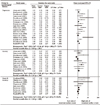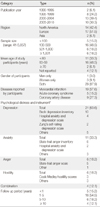1. Allison TG, Williams DE, Miller TD, Patten CA, Bailey KR, Squires RW, et al. Medical and economic costs of psychologic distress in patients with coronary artery disease. Mayo Clinic Proceedings. 1995. 70:734–742. doi:
10.4065/70.8.734.
2. Barlow DH. Anxiety and its disorders. 2002. 2nd ed. New York, NY: Guilford.
3. Barth J, Schumacher M, Herrmann-Lingen C. Depression as a risk factor for mortality in patients with coronary heart disease: A meta-analysis. Psychosomatic Medicine. 2004. 66:802–813. doi:
10.1097/01.psy.0000146332.53619.b2.
4. Chida Y, Steptoe A. The association of anger and hostility with future coronary heart disease: A meta-analytic review of prospective evidence. Journal of the American College of Cardiology. 2009. 53:936–946. doi:
10.1016/j.jacc.2008.11.044.
5. de Jonge P, Ormel J, van den Brink RH, van Melle JP, Spijkerman TA, Kuijper A, et al. Symptom dimensions of depression following myocardial infarction and their relationship with somatic health status and cardiovascular prognosis. The American Journal of Psychiatry. 2006. 163:138–144. doi:
10.1176/appi.ajp.163.1.138.
6. Denollet J, Gidron Y, Vrints CJ, Conraads VM. Anger, suppressed anger, and risk of adverse events in patients with coronary artery disease. American Journal of Cardiology. 2010. 105:1555–1560. doi:
10.1016/j.amjcard.2010.01.015.
7. DerSimonian R, Laird N. Meta-analysis in clinical trials. Controlled Clinical Trials. 1986. 7:177–188. doi:
10.1016/0197-2456(86)90046-2.
8. Egger M, Davey Smith G, Schneider M, Minder C. Bias in meta-analysis detected by a simple, graphical test. British Medical Journal. 1997. 315:629–634.
9. Egger M, Smith GD, Altman DG. Systematic reviews of observational studies in Systematic Reviews in Health Care: Meta-Analysis in Context. 2001. 2nd ed. London: BMJ Books.
11. Frasure-Smith N, Lesperance F. Depression and other psychological risks following myocardial infarction. Archives of General Psychiatry. 2003. 60:627–636. doi:
10.1001/archpsyc.60.6.627.
12. Gorkin L, Schron EB, Brooks MM, Wiklund I, Kellen J, Verter J, et al. Psychosocial predictors of mortality in the Cardiac Arrhythmia Suppression Trial-1 (CAST-1). American Journal of Cardiology. 1993. 71:263–267. doi:
10.1016/0002-9149(93)90788-E.
13. Higgins JP, Thompson SG, Deeks JJ, Altman DG. Measuring inconsistency in meta-analyses. British Medical Journal. 2003. 327:557–560. doi:
10.1136/bmj.327.7414.557.
14. Hopkins WG. An introduction to meta-analysis. Sportscience. 2004. 8:20–24.
15. Kent LK, Shapiro PA. Depression and related psychological factors in heart disease. Harvard Review of Psychiatry. 2009. 17:377–388. doi:
10.3109/10673220903463333.
16. Lemesle G, Sudre A, Modine T, Delhaye C, Rosey G, Gourlay T, et al. High incidence of recurrent in stent thrombosis after successful treatment of a first in stent thrombosis. Catheterization and Cardiovascular Interventions. 2008. 72:470–478. doi:
10.1002/ccd.21709.
17. Leroy M, Loas G, Perez-Diaz F. Anhedonia as predictor of clinical events after acute coronary syndromes: A 3-year prospective study. Comprehensive Psychiatry. 2009. 51(1):8–14. doi:
10.1016/j.comppsych.2009.01.011.
18. Lim ST. Assessment of prognosis and risk stratification in coronary artery disease. Nuclear Medicine and Molecular Imaging. 2009. 43:222–228.
19. Martens EJ, Hoen PW, Mittelhaeuser M, de Jonge P, Denollet J. Symptom dimensions of post-myocardial infarction depression, disease severity and cardiac prognosis. Psychological Medicine. 2010. 40:807–814. doi:
10.1017/S0033291709990997.
20. Mayou RA, Gill DM, Thompson DR, Hicks N, Volmink J, Neil A. Depression and anxiety as predictors of outcome after myocardial infarction. Psychosomatic Medicine. 2000. 62:212–219. doi:
10.1017/S0033291709990997.
21. McCabe PJ. Psychological distress in patients diagnosed with atrial fibrillation: The state of the science. Journal of Cardiovascular Nursing. 2010. 25:40–51. doi:
10.1097/JCN.0b013e3181b7be36.
22. Pedersen SS, Denollet J, de Jonge P, Simsek C, Serruys PW, van Domburg RT. Brief depression screening with the PHQ-2 associated with prognosis following percutaneous coronary intervention with paclitaxel-eluting stenting. Journal of General Internal Medicine. 2009. 24:1037–1042. doi:
10.1007/s11606-009-1054-1.
24. Roest AM, Martens EJ, Denollet J, de Jonge P. Prognostic association of anxiety post myocardial infarction with mortality and new cardiac events: A meta-analysis. Psychosomatic Medicine. 2010. 72:563–569. doi:
10.1097/PSY.0b013e3181dbff97.
25. Sirois BC, Sears SF Jr, Bertolet B. Biomedical and psychosocial predictors of anginal frequency in patients following angioplasty with and without coronary stenting. Journal of Behavioral Medicine. 2003. 26:535–551. doi:
10.1023/A:1026201818892.
26. Smith SC Jr, Allen J, Blair SN, Bonow RO, Brass LM, Fonarow GC, et al. AHA/ACC guidelines for secondary prevention for patients with coronary and other atherosclerotic vascular disease: 2006 update. Circulation. 2006. 113:2363–2372. doi:
10.1161/CIRCULATIONAHA.106.174516.
27. Song EK, Son YJ, Lennie TA. Trait anger, hostility, serum homocysteine, and recurrent cardiac events after percutaneous coronary interventions. American Journal of Critical Care. 2009. 18:554–561. doi:
10.4037/ajcc2009974.
28. Thune JJ, Signorovitch JE, Kober L, McMurray JJ, Swedberg K, Rouleau J, et al. Predictors and prognostic impact of recurrent myocardial infarction in patients with left ventricular dysfunction, heart failure, or both following a first myocardial infarction. European Journal of Heart Failure. 2011. 13:148–153. doi:
10.1093/eurjhf/hfq194.
29. Ziegelstein RC, Thombs BD, Coyne JC, de Jonge P. Routine screening for depression in patients with coronary heart disease, never mind. Journal of the American College of Cardiology. 2009. 54:886–890. doi:
10.1016/j.jacc.2009.01.082.






 PDF
PDF ePub
ePub Citation
Citation Print
Print






 XML Download
XML Download